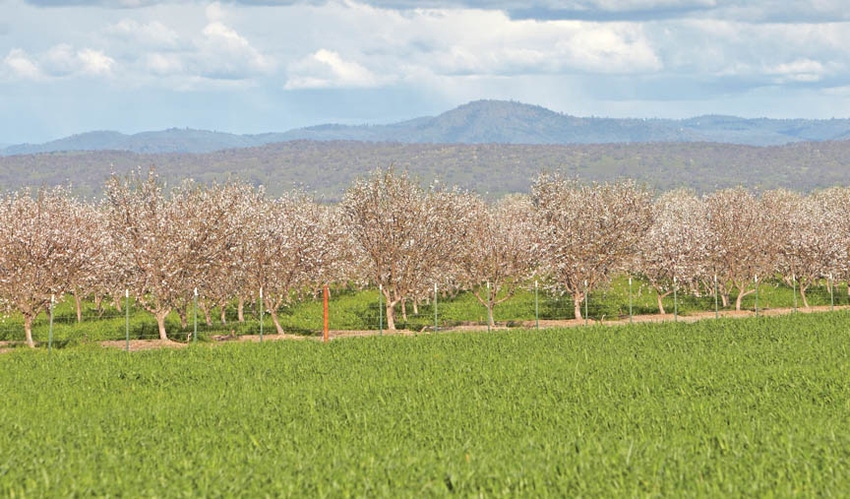March 21, 2011

Gabriele Ludwig, Associate Director, Environmental Affairs; Bob Curtis, Associate Director, Agricultural Affairs; Almond Board of California
This article is the first in a series on considerations for replanting an almond orchard (For the second article in the series, please see: Rootstock decisions vital to replanted almond orchards)
Almond growers have several issues to consider before replanting an orchard. Pest history in the previous orchard, cultural considerations, production goals and regulatory limitations are a few of the variables that will affect orchard replant decisions. In the next few issues, we will look more closely at some of these considerations and how Almond Board-funded research is helping growers make the best decisions for replanting their orchard.
This first article in the series looks in general terms at those “big ticket” items that growers should be thinking about before replanting an orchard. Next month we will examine more closely the variables that go into rootstock and variety selection. And in May we will look more closely at soil fumigation and pest management issues.
UC Merced County Farm Advisor David Doll, who gave a presentation on replant considerations at the 2010 Almond Industry Conference last December, says growers planning to replant an orchard should come up with a strategy they can afford that will give sustainable performance throughout the next generation. Failing to assess these big-ticket items prior to replant can result in dead trees, weak trees and/or major hits to crop production down the line.
The first step in putting together such a strategy, Doll says, is to look at the orchard’s history.
“Your previous orchard is the best learning resource that you have,” Doll says.
Before pulling out an older orchard, look for weak spots by surveying the orchard on foot or obtaining visual images through resources such as GoogleEarth. Once identified, growers can address the causes of that variability through control strategies that include cultural practices, such as changes in irrigation management, soil fumigation and rootstock selection.
Based on the orchard’s past history, replant problems can be separated into four general categories: 1) Abiotic factors related to physical and chemical conditions; 2) Aggressive pathogens and pests, such as Phytophthora, Armillaria, Verticillium and ten-lined June beetle; 3) Plant parasitic nematodes; and 4) Replant disease — a microbe-induced growth condition that is nearly universal in varying degrees to stone fruit orchards, such as almonds, replanted to previous stone fruit ground.
First, variability as a result of physical and chemical conditions can be addressed through cultural practices such as soil modification (ripping, backhoeing or slip-plowing) or changes in management practices related to irrigation, nutrition and weed management systems.
Second, assess aggressive soilborne pathogens and pests named above that were present in the previous orchard. These pathogens and pests are found in a variety of soil types and are often best managed through a combination of fumigation, cultural practices and resistant rootstocks, as fumigation alone will not correct problems. Strategies for using these management techniques will be discussed in more detail later in the series.
Nematode testing
Third, take the time to test soils for nematodes and choose the strategy that best fits the specific nematode pressure in the field.
Moderate nematode pressures can be mitigated through the selection of resistant rootstocks, strip fumigation or cultural practices that include managing weeds for one to two years prior to orchard removal or rotating in a cover crop such as Piper Sudangrass. More severe pressures will require broadcast soil fumigation.
Soil fumigation strategies require several considerations that will be discussed in more detail in the May issue. Keep in mind, though, that traditional fumigation with methyl bromide has become very restricted, and what short supply is available in many cases has become cost prohibitive. In addition, other soil fumigants commonly used in almonds are now restricted by regulatory constraints, particularly in the San Joaquin Valley where air quality emissions are a significant concern.
Fourth, the most common issue when replanting almonds back-to-back will be replant disease. Replant disease stunts, and at times, kills young trees with roots that underperform at taking up water and nutrients.
Research has shown that fallowing almond ground for at least one year prior to replanting or planting a non-host cover crop can provide a significant benefit for mitigating replant disorder, particularly in coarser-textured soils that are more prone to the condition.
Switching rootstock parentage may provide some control, but may not be worth the sacrifice to horticultural benefits.
If fallowing is not an option for replant disease, consider fumigation with a strip-row or tree-site treatment with a fumigant that contains chloropicrin.
The Almond Board is currently funding research trials throughout the state to provide information about replanting older orchards that growers can integrate into their own decision-making. Field trials are looking at fumigation options to reduce pest pressures and emissions, field evaluation of almond rootstocks and varieties, and many other factors that will help growers make an informed decision.
For details on Almond Board-funded research and other related research projects in California, visit the Almond Board website at AlmondBoard.com, click on “resources” and then “research reports.” For more on almond orchard fumigation, go to AlmondBoard.com/farmpress15.
You May Also Like




